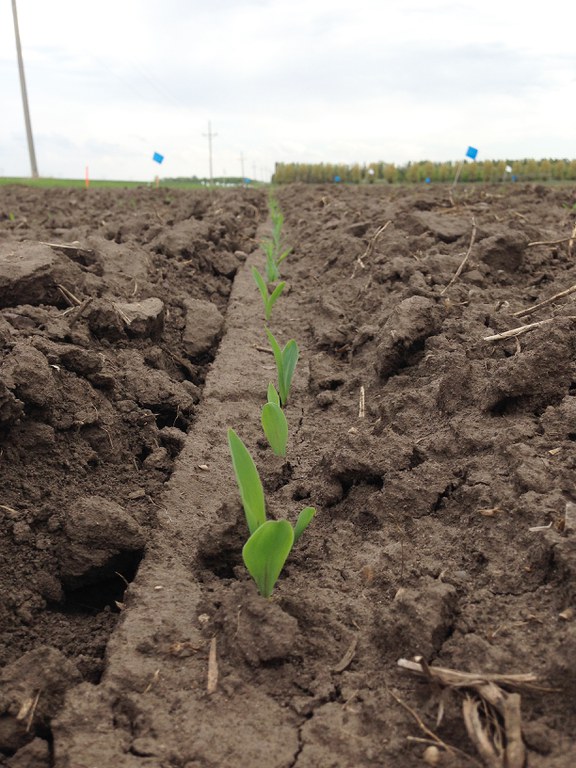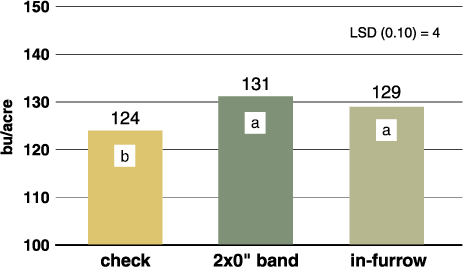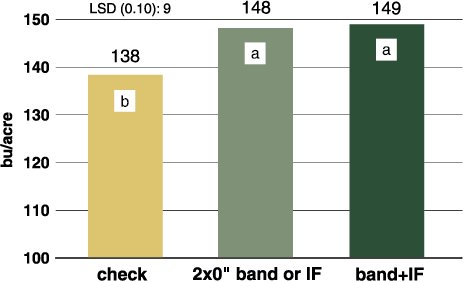Corn Response to Phosphorus Starter Fertilizer in North Dakota (A1851, May 2017)
Availability: Web only

The acres of corn planted in North Dakota for grain increased from about 1 million in 2000 to more than 3 million in recent years. With the exception of nitrogen, corn plant nutrition research in North Dakota has been limited until recently. Field trials in North Dakota were initiated in 2007 to evaluate starter fertilizer recommendations derived from other north-central U.S. land-grant universities.
NDSU recommends phosphorus (P) starter fertilizer be placed within 2 inches of the seed in-furrow (also called “pop-up”) or banded away from the seed at planting time (Franzen, 2014). The P starter fertilizer provides the potential to increase early season plant growth by increasing nutrient uptake, and ultimately increase grain yield and test weight, plus decrease grain harvest moisture content.
This publication summarizes results of NDSU P-based starter fertilizer trials conducted in east-central North Dakota that evaluated corn grain yield response, primarily with liquid 10-34-0 applied using different methods and rates.
Materials and Methods
Location and years: NDSU Carrington Research Extension Center; 2007-16
Soil: Heimdal-Emrick and Fram-Wyard loams; 2.6 to 3.8 percent organic matter; 5.9 to 8.2 pH; 3 to 20 parts per million (ppm) P (Olsen test; most sites in the low to medium recommendation ranges, with P levels less than 7 ppm)
Standard treatments: 10-34-0 applied in a 2- by 0-inch band (2 inches horizontally placed from planted seed) with a single-disk coulter or in-furrow with seed (Photo 2). P application rates were based on NDSU corn fertilizer recommendation tables (Franzen, 2014).
Experimental design: Randomized complete block with four replications
General: The dryland trials were conducted using strip- or conventional-tillage systems. Responses did not appear to relate to the tillage system used. Corn row spacing was 22 or 30 inches. Low amounts of nitrogen were included with the starter fertilizer treatments. No additional fertilizer P was applied to supplement P in the starter treatments. Best management practices, including providing adequate levels of plant nutrients besides P, were used for corn production.
Results and Discussion
In individual trials (site-years), corn grain yield response did not always occur among fertilizer treatments.
Averaged across eight site-years, band- and in-furrow-applied 10-34-0 increased yield 5 to 7 bushels per acre (4 to 5 percent), compared with the untreated check (Figure 1). Yield between the two starter fertilizer application methods was statistically similar. Yield increased with starter fertilizer, compared with the untreated check, in two of eight of the trials.

Figure 1. Corn grain yield between band and in-furrow application of 10-34-0, Carrington, 2008-16 (8 site-years).*
Plant stand was similar between band (30,100 plants per acre) and in-furrow (28,800 plants per acre), with 10-34-0 application rates ranging from 2.5 gallons per acre (gpa) up to 6 gpa. Averaged across five site-years with 10-34-0 rates of 5 to 6 gpa, the number of days from corn seed planting to plant emergence was similar among the untreated check, and band and in-furrow application of fertilizer (data not shown).
Also, ear silks emerged slightly earlier (one to two days) with starter fertilizer application, compared with the untreated check. Averaged across 11 site-years, grain harvest moisture was similar and test weight increased slightly with band applications of 10-34-0, compared with the untreated check (Table 1).

Averaged across three site-years, yield tended to increase, although the increases were not statistically significant, with banded 10-34-0, compared with broadcast application (Figure 2). This supports the recommendation that banded P applications are more efficient in producing yield, compared with broadcast P applications for corn.

Figure 2. Corn grain yield between 10-34-0 application methods, Carrington, 2013-15 (3 site-years).*
The banded fertilizer rate was one-third less (with reduced cost), compared with the broadcast rate in the trials. The broadcast fertilizer was applied immediately after planting without mechanical incorporation in 2013. The broadcast fertilizer was preplant applied and incorporated in 2014-15.
Yield increased with 3 and 6 gpa of in-furrow-applied 10-34-0, compared with the untreated check, averaged across six site-years (Figure 3); however, yield was similar between fertilizer rates.

Figure 3. Corn grain yield between rates of in-furrow applied 10-34-0, Carrington, 2007-16 (6 site-years).*
Averaged across three site-years, yield did not improve with a split application of 10-34-0 using band plus in-furrow placement, compared with similar rates of only band or in-furrow application of fertilizer (Figure 4).

Figure 4. Corn grain yield between 10-34-0 fertilizer application methods, Carrington, 2014-16 (3 site-years).*
Averaged across three site-years, a yield advantage did not occur with deep-band- or deep-band plus in-furrow-applied 10-34-0, compared with band-applied fertilizer at planting (Table 2). The deep-banded fertilizer was applied at the 5- to 6-inch depth in a 0.75-inch band in October or November 2010 and 2012, and May 2013 using strip tillage. Deep-banded plus in-furrow-applied 10-34-0 rates were one-half of total P for other treatments.

Table 2. Corn grain yield with deep-band (5-6 inches deep) applied 10-34-0, Carrington, 2010 and 2012-13 (3 site-years).*
At similar rates of in-furrow-applied P, the three site-year yield average with low-salt fertilizer 6-24-6 was similar to 10-34-0 (Figure 5). Also, plant stands were similar between the two fertilizers. Potassium (K) soil levels in the trials were high to very high.

Figure 5. Corn grain yield between in-furrow applied 10-34-0 and 6-24-6 fertilizer, Carrington, 2014-16 (3 site-years).*
Summary
Corn grain yield was similar with band and in-furrow 10-34-0 application, and starter fertilizer increased yield, compared with the untreated check. Also, test weight increased slightly with band application of 10-34-0, compared with the untreated check.
Yield was similar between the 3- and 6-gpa rates of in-furrow-applied 10-34-0.
Yield did not improve with a split application of 10-34-0 using band plus in-furrow placement, compared with similar rates of only band- or in-furrow-applied fertilizer.
Deep-band- (5 to 6 inches deep, fall or spring placed) or deep-band plus in-furrow-applied 10-34-0 had similar yield as the planting-time band-applied fertilizer.
Yield was similar between in-furrow-applied 10-34-0 and the low-salt fertilizer 6-24-6.
Reference
Franzen, D.W. 2014. Soil fertility recommendations for corn. NDSU Extension Service publication SF722 (Revised).
Research was partially supported by the North Dakota Corn Utilization Council.
May 2017

